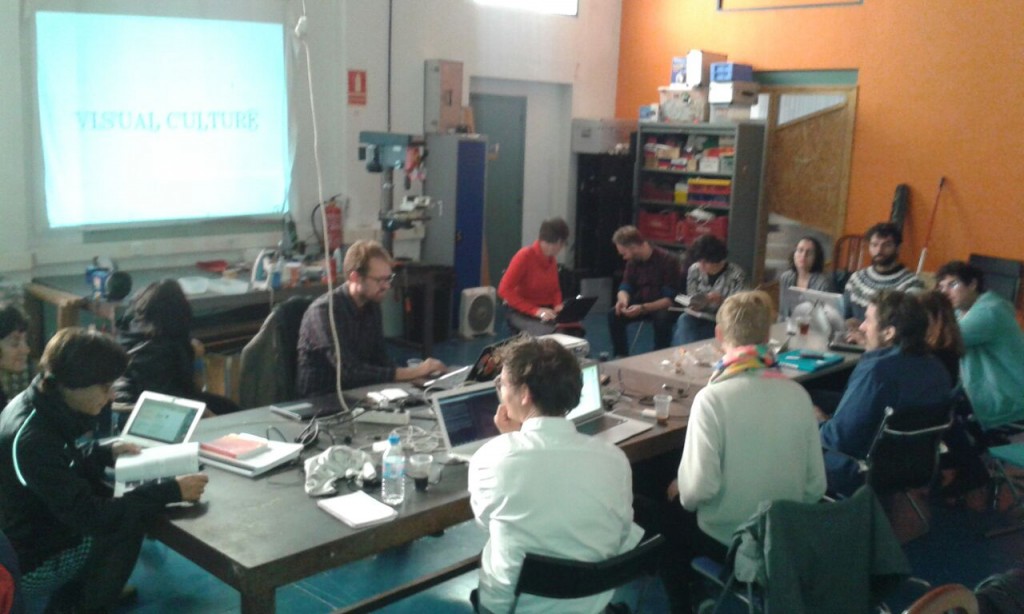Mixed experience: when ‘users’ and ‘developers’ make tools together by Femke Snelting & OSP (Open Source Publishing)
Following the aim to explore the landscape between ‘users’ and ‘developers’ on digital tools, PIPES_BCN organized on November 7th a mixed experience inviting people prom Constant, a Brussels’ based association for Arts and Media, and design caravan OSP, in the framework of the Free Culture Forum.
The workshop reflected on the necessity of shift out our digital practices away from the pressures of meritocracy and the limits of the technocentrism, and the need to make tools together.
Participants were diverse, coming from graphic or fashion design, art, architechture, culture theory or activism. After the introductions, Femke Snelting from Constant, highlighted that design can be regarded as a strategy driven by tools which must be considered: they somehow channel experiences and expectations, and they condition the way we work. In this sense, Femke said, when we speak about tools we’re also talking about interfaces, so we have to blur the line between them.
After displaying this first thoughts, pals from Open Source Publishing Gijs De Heij and Eric Schrijver presented Visual Culture, a tool / interface that comes from the world of programming to share and publish any design project with the possibility to see and retrieve any previous version. Visual Culture provides an archive, a tool to publish and a tool to collaborate and share based on Git versioning software.
In this online software, each project is explained and each step is recorded, so a biography of those projects is built, basing future conversations. Through Visual Culture people can share their creative process on the web instead of taking it for itselfs. Knowledge is shared and exchanged, because it invites participants to create open source projects, so everyone can download it.
Saying so, the Tool Parade was launched, focusing on three different tools:
- Etherpad-to-graphviz, a collaborative graph visualization tool developed by OSP, where nodes (concepts, ideas, people, etc.) are linked to each other in different ways.
- html2print, also developed by OSP, is a little tool to start a print project using HTML, less/CSS and Javascript/Jquery to design it.
- Feed-to-be-fed comes from a streaming project where multiples images were uploaded by different users and displayed on a screen in public space, creating a public animation. Doing so, a narrative without hierarchy was built.
Participants separated in groups that tried and reflected on this tools according to their interests. The team that used etherpad-to-graphviz tried to represent a conversation between persons. As it works with coding language, they learnt the amount of layers between people and machines, and realized that average people don’t use the same languages as machines.
The second team worked on html2print, a tool that links web and print which can display text, code raw and print format. Using this, they tried to answer some of the questions setted for the workshops (as: is this a tool or an interface? How do you use it, or would you want to use it? Who has made this tool/interface, and why? among others). Team concluded that there’s a change on design: print design thinks on a static canvas, thinking first on a space and then organizing it. On web content is more fluent, and the design is thought taking in account dynamic issues. Similar to this software, OSP developed Ethertoff, a simple collaborative web platform, much resembling a wiki but featuring realtime editing thanks to Etherpad. Its output is constructed with equal love for print and web. Based on this, there’s an other software avaliable at f-u-t-u-r-e.org where users can change design and content and printing it in pdf.
Regarding to Feed-to-be-fed, the participants talked about the tool as an open interface where people can collaborate in real time uploading videos from it’s computer, creating a collaborative work settled in the public space. During the conversations, several points related to the future interface manifesto appeared.
14 assumptions about interfaces
- What if we could work/thing with the tool? What if we could dialogue with the tool?
- If you don’t realize the presence of the tool, you’ll even think about it.
- Interfaces are part of out technobiography, are part of the way we live with tecnhnology.
- We should interrogate tools (and interfaces): ask different things to different tools.
- Some interfaces might have instruction manual to show it’s performance and to enable user to modify it.
- Can all the interfaces be seen under the same ethical light? Should we classify them in different types? (i.e. communication vs creation interfaces).
- Averages users could say: Knowing is trouble, not knowing is bliss.
- We don’t want the tool to go away, not to make it INVISIBLE. We want the tool to be part of the world, not a bridge to “reality”. The tool is part of the reality.
- Assuming that computers are here to stay, instead of make them “disappear”, how to have a more natural wanted foreground vs unnatural unwanted background.
- Internet’s has agency power on people: always connected, always uploading, faster.
- Thinking on transparency and honesty of interfaces: there is a lot of decisions we take every time, we cannot see ALL, do ALL, deal with ALL, so it’s much more about what we CHOOSE.
- Regarding internet GUI: It was very interesting to see how HTML teaching became a way to professionalize, so students accepted learning html as an standard.
- There are some examples of transparent interfaces: Inkscape, Laidout.
- Commercial products shape the way professional interfaces should look: Gimp has to look “professional” so it becomes a stokolm sindrom to look like photoshop.

